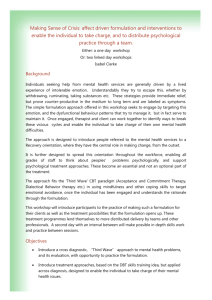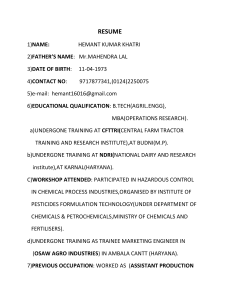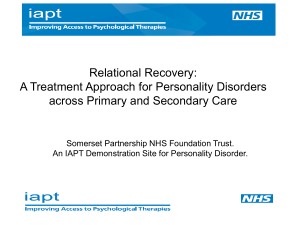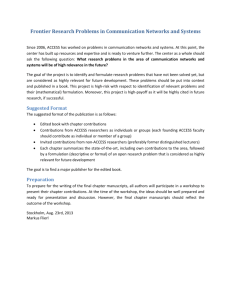The Emotion Focused Formulation Approach
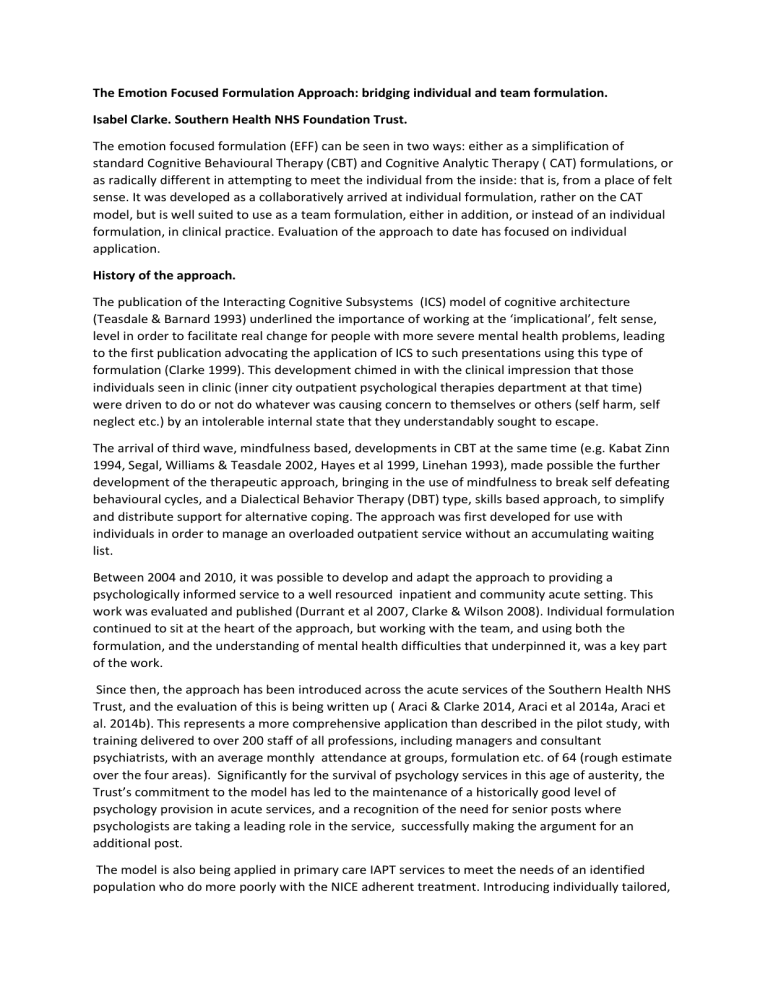
The Emotion Focused Formulation Approach: bridging individual and team formulation.
Isabel Clarke. Southern Health NHS Foundation Trust.
The emotion focused formulation (EFF) can be seen in two ways: either as a simplification of standard Cognitive Behavioural Therapy (CBT) and Cognitive Analytic Therapy ( CAT) formulations, or as radically different in attempting to meet the individual from the inside: that is, from a place of felt sense. It was developed as a collaboratively arrived at individual formulation, rather on the CAT model, but is well suited to use as a team formulation, either in addition, or instead of an individual formulation, in clinical practice. Evaluation of the approach to date has focused on individual application.
History of the approach.
The publication of the Interacting Cognitive Subsystems (ICS) model of cognitive architecture
(Teasdale & Barnard 1993) underlined the importance of working at the ‘implicational’, felt sense, level in order to facilitate real change for people with more severe mental health problems, leading to the first publication advocating the application of ICS to such presentations using this type of formulation (Clarke 1999). This development chimed in with the clinical impression that those individuals seen in clinic (inner city outpatient psychological therapies department at that time) were driven to do or not do whatever was causing concern to themselves or others (self harm, self neglect etc.) by an intolerable internal state that they understandably sought to escape.
The arrival of third wave, mindfulness based, developments in CBT at the same time (e.g. Kabat Zinn
1994, Segal, Williams & Teasdale 2002, Hayes et al 1999, Linehan 1993), made possible the further development of the therapeutic approach, bringing in the use of mindfulness to break self defeating behavioural cycles, and a Dialectical Behavior Therapy (DBT) type, skills based approach, to simplify and distribute support for alternative coping. The approach was first developed for use with individuals in order to manage an overloaded outpatient service without an accumulating waiting list.
Between 2004 and 2010, it was possible to develop and adapt the approach to providing a psychologically informed service to a well resourced inpatient and community acute setting. This work was evaluated and published (Durrant et al 2007, Clarke & Wilson 2008). Individual formulation continued to sit at the heart of the approach, but working with the team, and using both the formulation, and the understanding of mental health difficulties that underpinned it, was a key part of the work.
Since then, the approach has been introduced across the acute services of the Southern Health NHS
Trust, and the evaluation of this is being written up ( Araci & Clarke 2014, Araci et al 2014a, Araci et al. 2014b). This represents a more comprehensive application than described in the pilot study, with training delivered to over 200 staff of all professions, including managers and consultant psychiatrists, with an average monthly attendance at groups, formulation etc. of 64 (rough estimate over the four areas). Significantly for the survival of psychology services in this age of austerity, the
Trust’s commitment to the model has led to the maintenance of a historically good level of psychology provision in acute services, and a recognition of the need for senior posts where psychologists are taking a leading role in the service, successfully making the argument for an additional post.
The model is also being applied in primary care IAPT services to meet the needs of an identified population who do more poorly with the NICE adherent treatment. Introducing individually tailored,
as opposed to diagnosis specific formulation into IAPT is a development which has potential to reclaim territory for psychology, as our skills would be required for the supervision of such formulation. A recent development is its application to a new culturally adapted CBT with a mindfulness focus.
Rationale: current response and past trauma.
The understanding of mental health difficulties underpinning EFF is simple. The behaviours underlying all mental health diagnoses are understandable attempts to manage intolerable internal states; a ‘what it feels like to be me now’ that is simply too challenging to face.(Clarke 2009). Self harm and withdrawal have been mentioned as common reactions. Ruminative worry keeps anxiety on the boil; changing the agenda – ‘if I wash my hands enough, if I am thin enough….’ appear to offer solutions, and for those high on the schizotypy spectrum (Claridge 1997), the option of escape to another dimension (psychosis) is available. As immediate strategies to cope with adversity, most of these are familiar to all of us as short term responses, including one favoured in our society: use of alcohol.
Teams can understand this much when it is brought home to them through a training exercise.
Where straight empathy founders is in the need to factor in the effect of past trauma, and the compound effect of repeated trauma, on people’s response to current adversity and to their experience of self. ICS provides a powerful, cognitive science based, explanation for the way that trauma memory operates outside of time and disrupts an individual’s ability to form a coherent and good enough experience of self, leading to that desperate need to escape. Brewin and others’ research ( Brewin, Dalgleish & Joseph, 1996) into trauma memory tells the same story.
EFFA encapsulates all this extremely simply. The intolerable internal state is identified as the source of whatever problem behaviour, experiences (in the case of psychosis), etc. that has brought the individual to the service. This is drawn as a jagged shape in the centre of the diagram. The immediate trigger is identified, linked to past threat that it has ‘woken up’, and the way they combine to produce the intolerable feeling at the heart of the diagram is normalized. The past and triggering events are encased in a box. These are the important context for the distress, but are unlikely to be amenable to short term change. The maintaining cycles are then drawn out collaboratively as precise behavioural analyses, arising out of the spiky centre, leading to short term relief (the reinforcer), but ultimately feeding back into the spike and so continually maintaining and intensifying the intolerable state. Where this is constructed collaboratively with an individual, it is vital that they can own both the reinforcer and the ultimately self defeating aspect of the coping strategy.
Choice of language is crucial to this formulation and represents another subtle difference in comparison with other approaches. The language needs to be immediate, everyday and ideally uses the service users’ own words. This requires a translation of the professional jargon that trips readily off the tongue, and can indeed be readily picked up by the service user. Phrases like ‘low self esteem, maladaptive coping’ etc. need to be translated into respectfully phrased behavioural alternatives that bring home inescapably what is actually going on, or has gone on. Another aspect of the choice of language concerns sensitivity to what the individual is ready to face at this point in time. This can be particularly relevant in relation to the feelings named at the centre and the brief encapsulation of the past. For some people, past abuse is readily acknowledged so that naming it is not an issue. For others, a phrase like ‘bad things in the past’ is as much as they actually want to see down on paper, but this is sufficient to make the point that there are good reasons why the current situation is so unmanageable. The driving feeling at the heart of the diagram can be described with
as much vagueness or precision as is right for that person – from a question mark to a number of words and phrases, including cognitions such a ‘I am a failure’ if spontaneously expressed by the individual.
The completed diagram is usually received as an accurate (if not always welcome) depiction of their predicament, and as it illustrates clearly how stuck they remain while using these strategies, provides a good starting point to look at where to break the cycles. This is the hopeful part of the message. The challenging part is easier to hear because of the powerful validation provided by placing the spike in the centre of the diagram and normalizing the effect of the past.
Distributed working
One effect of this formulation is to break down the problem in a way that suggests quite straightforward skills based, behavioural changes, which can be taught and supported by someone other than the formulating therapist. The therapist undertaking the formulation needs to have adequate background and supervision as, though simple, the approach Is quite subtle and could be very counter-productive if done badly. In inpatient, Community Treatment Teams, and other team settings this is an opportunity to involve the team in the psychological approach. Ideally they need some training in the model, so that they can see mental health problems in these terms, and are not just stuck with diagnosis, and can understand the impact of past trauma on current distress, as a basis for more accurate empathy. The formulation that has been arrived at collaboratively with the individual can be shared with the team, and the interventions identified to break the vicious cycles can then be owned and supported by the whole team.
There are different ways in which the formulation can be shared with the team. It can be effected by presenting the formulation to an MDT meeting and discussing how to embed in planning. Working in the inpatient unit, it often made sense to involve the key nurse, or other member of the ward team in the formulation meeting. Without prompting they usually were able to identify areas where they could support the next steps indicated by the formulation with the service user. Similarly, in preparation for discharge, it was important to find natural allies for the practice and development of new skills by inviting family, partner, carer etc. to a meeting where the service user could explain, using the diagram (which had often already been shared to help important others to understand), what skills they were trying to use and what they would find helpful in terms of support – and what would be less helpful. The therapist then listed these in a written document for all to take away. This approach of using natural supporters is being developed for the cross cultural adaptation.
In the acute setting, programmes were provided by the service, to be accessed equally by the in- and outpatient arms of acute, to support new skills to address the commonest vicious circles.
Mindfulness is an obvious first step for revising habitual patterns, and is accessible in safe and simple form early on in the admission, indicating provision of frequent mindfulness groups on the ward. The
ICS/DBT model, placing the disjunction between emotional and rational processing that occurs at states of high and of low arousal, at the heart of mental health difficulties, points to the centrality of arousal management, both down (stress control) and up (activity scheduling etc). This is highly suitable for delegation, given manuals, support etc. As a dysfunctional self/self relationship is equally central to mental health presentations, we added a ‘Compassionate Friend’ group to address this. A programme introducing non-stigmatizing ways of understanding voices and other anomalous experiences, that helps to preserve self-esteem while teaching and promoting the use of selfmanagement skills ( Wilson, Clarke & Philips 2009, Clarke 2010) was part of the original pilot. Across the Trust this topic is covered by various psychosis groups. A DBT based, short ( 8 – 12 sessions)
Emotional Coping Skills Group lies at the heart of the programme.
These groups do not only supply the skills for service users to break the self defeating patterns identified in the formulation. They are a crucial means to introduce the wider staff team to psychological working, and ultimately, the entire MDT. Management co-operation and adequate staffing are both essential to enable interested staff to learn to deliver the programmes by first observing, then co-facilitating, and maybe becoming facilitators in turn; maybe using their familiarity with the manuals in one to one work and coaching the use of new skills at the point when they are really needed. This is not always easy to achieve. It was most complete during the original pilot.
However, where staff start to become meaningfully engaged with the psychological programme in this way it greatly benefits the whole service. Psychological interventions become ‘the treatment’ with equal status with medication, and service users are consistently encouraged to use their skills and attend groups.
Team Formulation
Hopefully it is apparent that when this system is working well it promotes psychological thinking throughout the team and helps staff to see peoples’ problems and their solution in psychological terms. The way in which it is applied in acute services encourages seeing the formulation, originally derived from an individual, collaborative process, as a more public document, shared with the rest of the team, informing care planning, and frequently shared with the service users’ family/carers. The language used is chosen with this in mind and the sensitivity of the service user with regard to particular phrases etc. is respected, balanced with the power of naming what has happened and its impact on the current situation.
The same model of formulation can be and frequently is used as a purely team formulation in the absence of an individual version. This might be where the team needs to understand someone who has not engaged sufficiently for an individual formulation to be practicable; where there has not been adequate therapy resource, or indeed, in a service where there is insufficient capacity for individual formulation so that the psychological resource is sensibly confined to reflective practice/case discussion.
This model has particular strengths used as a team formulation. For one, empathy is inescapable.
Behaviour is sourced to the internal reality for that person; the impact of trauma is emphasized, so enabling accurate as opposed to ‘false’ empathy. By false empathy, I mean the sort of process that concludes that behaviour is manipulative in intent. Behaviour such as repeated ligaturing has the effect of annoying staff and making discharge difficult. Understanding the desperation behind the behaviour (or its original where it has become habitual), and the source of that desperation, for instance in past trauma, is crucial for the staff group not dismissing it as manipulative in intent and therefore unworthy of empathy. This type of re-appraisal lies at the heart of developing more compassionate services.
The formulation is also powerful in use with teams in clearly identifying the behavioural cycles maintaining the problem, and so the most efficient targets for intervention. By situating the past and the triggers in the past it discourages further exploration of areas that can distract from the immediate and challenging task of working on change, at the same time as emphasizing their importance for understanding the present. This is also useful for assessing motivation on the part of both the service user and the team to work on change. Where the way ahead is clearly stated, it is easier to discern whether the parties are ready to accept this challenge. This can raise questions about the continuing involvement of the service with individuals where this is going nowhere, thus promoting more efficient use of resources.
This leads naturally to clarification of issues of positive risk taking. The formulation makes it very clear where the service has become part of the problem. The individual’s habitual solution to a situation they feel unable to face and address is to engage in behaviour that involves them with the service – attempting suicide being the commonest. Revealing this unavoidably makes possible a balanced risk assessment. The risks of, say, completed suicide, are acknowledged, but so are the risks of loss of independence, self efficacy, coping capacity if the service remains stuck in the rescuer role. Again, the formulation helps to save the service from self defeating activity.
Conclusion
Of course, other ways of formulating will cover all these areas. The strength of EFF lies in the immediacy of placing felt sense at the heart, thus inviting powerful empathy, and the inescapability of the message conveyed by clear and simple behavioural cycles, using everyday, jargon and theory free, language.
It is hoped that this article has given some idea of the operation and potential of the EFF, both as an individual formulation that can inform a team, and as a team formulation. More information, including manuals for group programmes, are available on www.isabelclarke.org
References
Araci, D & Clarke, I.(2014) Investigating the efficacy of a whole team, psychologically informed,
acute mental health service approach . In submission
Araci, D., Clarke, I., Pearce, K., Gatherer, C., & Johnson, G. (2014a). The perspective of the service user: Accounts of taking part in the Intensive Support Programme at an acute in-patient facility.
Unpublished manuscript.
Araci, D., Clarke, I., Pearce, K., Gatherer, C., & Johnson, G. (2014b). Staff milieu in acute in-patient settings: The impact of a whole service psychological approach to Recovery as applied to adult
mental health. Unpublished manuscript.
Brewin, C.R., Dalgleish, T. & Joseph, S. (1996). A dual representation theory of post-traumatic stress disorder. Psychological Review, 103, 670-686.
Claridge, G.A. (1997) Schizotypy: Implications for Illness and Health, Oxford: Oxford University Press.
Clarke, I. (2010 ) ‘What is Real and what is not’:Towards a Positive Reconceptualisation of
Vulnerability to Unusual Experiences. In I.Clarke, Ed. Psychosis and Spirituality: consolidating the
new paradigm. (2nd Edition) Chichester: Wiley
Clarke, I. (2009) 'Coping with Crisis and Overwhelming Affect: Employing Coping Mechanisms in the
Acute Inpatient Context'. In A.M. Columbus Ed. 'Coping Mechanisms: Strategies and Outcomes'.
Advances in Psychology Research Vol.63.Huntington NY State:Nova Science Publishers Inc.
Clarke, I. & Wilson, H.Eds. (2008) Cognitive Behaviour Therapy for Acute Inpatient Mental Health
Units; working with clients, staff and the milieu. London: Routledge.
Clarke, I (1999) Cognitive Therapy and Serious Mental Illness. An Interacting Cognitive Subsystems
Approach. Clinical Psychology and Psychotherapy, 6 375 - 383.
Hayes, S., Strosahl, K.D. & Wilson, K.G. (1999) Acceptance and Commitment Therapy, New York:
Guildford Press.
Kabat-Zinn, J., (1994) Wherever you go, there you are: Mindfulness Meditation for Everyday Life.
New York:Hyperion.
Linehan, M. (1993a) Cognitive Behavioral Treatment of Borderline Personality Disorder. New York:
The Guildford Press.
Segal, Z. W., Williams J. M. G. & Teasdale J. D.(2002). Mindfulness based cognitive therapy for
depression: a new approach to preventing relapse. New York: Guildford Press.
Teasdale, J.D. and Barnard, P.J. (1993) Affect, Cognition and Change: Remodelling Depressive
Thought. Hove UK: Lawrence Erlbaum Associates.
Wilson, H, Clarke, I & Phillips,R., (2009) Evaluation of an Inpatient Group CBT for Psychosis Program
Designed to Increase Effective Coping and Address the Stigma of Diagnosis Psychosis.
http://www.isabelclarke.org/clinical/icspsychosis.shtml
